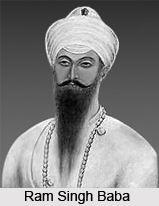 Ram Singh Baba was born on 3rd February 1816 at Bhaini Raiyan, in Ludhiana district, Punjab. He was the leader of the Namdhari or Kuka Movement. He first joined the Sikh army under Maharaja Ranjit Singh, at a very young age of 20 years and in the later half of his life. He was highly influenced by Indian philosophies.
Ram Singh Baba was born on 3rd February 1816 at Bhaini Raiyan, in Ludhiana district, Punjab. He was the leader of the Namdhari or Kuka Movement. He first joined the Sikh army under Maharaja Ranjit Singh, at a very young age of 20 years and in the later half of his life. He was highly influenced by Indian philosophies.
He met the famous saint and philosopher, Baba Balak Singh in the year of 1841, at an age of 24 years. Philosophy of Baba Balak Singh influenced him, very much. He was so much influenced that he resigned from the army service and came back to Bhaini. After coming back to Bhaini, he was engaged in spreading and disseminating the thoughts and messages of Baba Balak Singh among the common people.
Ram Singh Baba laid down the code of conduct for his followers, famous as the Namdhari Kukas, on the Baisakhi day, 14th April 1857. He ordered the followers to abstain from eating meat, drinking and shipping of tombs or Samadhis. He asked them to lead a simple life. He is also known as Satguru by his followers.
He strongly opposed the rule of British and asked people to boycott the British goods, schools and government services, as well. The British government exiled Ram Singh Baba from Punjab, following a lot of confrontation between the government and Kukas, in the 1870s and 1880s. The British government took him to Rangoon in the later period and Baba Ram Singh, died on 29th November 1885. In Punjab he was the originator of non violence and civil disobedience movement. His ideas played a key role in securing India`s Independence.
This article is a stub. You can enrich by adding more information to it. Send your Write Up to content@indianetzone.com









